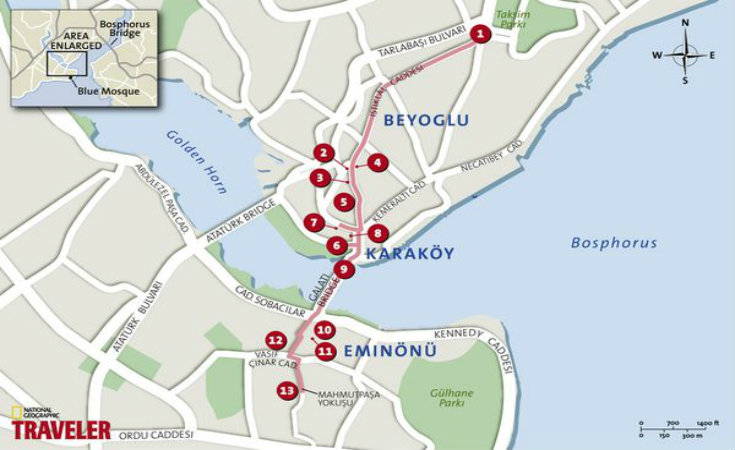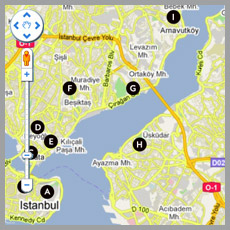 Legs can be “faster than combustion engines in Istanbul.”—Hugh Pope, author, Sons of the Conquerors: The Rise of the Turkic World and Turkey Unveiled. Pope suggests this swift route through a chain of memorable quarters, starting in Pera, which in Byzantine and Ottoman times denoted “the opposite shore,” where foreigners lived. Start at (1) Taksim Square, a massive roundabout with a 1928 monument to Atatürk’s Republic, bus and subway depots, and flashy video billboards. Head down the pedestrian boulevard of İstiklal Caddesi (Independence Avenue) to take in Beyoğlu district’s lively music shops, theaters, embassies, churches, and diverse, youthful crowds. This neighborhood’s Parisian feel nods to its history as a center of European-style business, life, and culture.
Legs can be “faster than combustion engines in Istanbul.”—Hugh Pope, author, Sons of the Conquerors: The Rise of the Turkic World and Turkey Unveiled. Pope suggests this swift route through a chain of memorable quarters, starting in Pera, which in Byzantine and Ottoman times denoted “the opposite shore,” where foreigners lived. Start at (1) Taksim Square, a massive roundabout with a 1928 monument to Atatürk’s Republic, bus and subway depots, and flashy video billboards. Head down the pedestrian boulevard of İstiklal Caddesi (Independence Avenue) to take in Beyoğlu district’s lively music shops, theaters, embassies, churches, and diverse, youthful crowds. This neighborhood’s Parisian feel nods to its history as a center of European-style business, life, and culture.
At (2) Tünel, the café-lined terminus square for İstiklal’s traditional red trolleys, take a short side trip down (3) Galip Dede Caddesi, a cobbled lane lined with modern and traditional musical-instrument shops. On the left pass (4) Galata Mevlevihanesi (Seyh Galip Caddesi 15; www.turkeytravelplanner.com/go/Istanbul/Sights/Beyoglu/mevlevi_program.html), a former dervish monastery where the 700-year-old Sufi whirling ritual (sema) is still performed on weekends. End at the landmark (5) Galata Tower (Galata Kulesi Meydanı; www.galatatower.net), a 14th-century stone guard post built by Genoese settlers to protect their community.
Back at Tünel, Europe’s second oldest subway will take you to the Golden Horn sea inlet. Disembark on the main street of (6) Karaköy (Yüzbası Sabahattin Evren Caddesi), an ancient area of docks and warehouses, now a fascinating warren of shops selling everything from screwdrivers to scaffolding. To the left on the hill behind are the grand edifices of (7) Bankalar, or Voyvoda Caddesi, the former Ottoman banking district home to modern banks, money museums (Voyvoda Caddesi 35/37; www.obmuze.com/eng/muzeninicinden.asp), and cultural centers (Bankalar Caddesi 2; kasagaleri.sabanciuniv.edu).
Off Karaköy Square is (8) The Quincentennial Foundation Museum of Turkish Jews (Perçemli Sokak; www.muze500.com). Cross (9) Galata Bridge (Galata Köprüsü) at street level to peek into the buckets of multitudes of fishermen, or downstairs to be fished yourself by hawkers from the touristy restaurants, which line the bridge’s outdoor terrace.
Arriving in Eminönü on the other side, visit (10) Yeni Camii (Eminönü Meydanı), a 17th-century mosque (www.turkeytravelplanner.com/galeri/istanbul_winter/photopages/004.html) built by a sultan’s mother. In its courtyard are tombs of four sultans. Next door browse the spice and traditional medicine shops of (11) Mısır Çarşısı (Egyptian Bazaar), or take in the quirky plant and pet market in the courtyard on the eastern side, which sells saplings next to bunnies and medicinal leeches.
Outside the west walls of the bazaar, the specialty foods and kitchen supply shops of (12) Tahtakale (Hasırcılar Caddesi) are worth a short detour. Buy a bag of Istanbul’s best Turkish coffee from Kurukahveci Mehmet Efendi (Tahmis Sokak 66; www.mehmetefendi.com/eng/pages/index.html) on the first corner. The bazaar’s southern gate leads to (13) Mahmutpaşa Yokuşu, Mahmutpaşa’s glitzy district, for discount bridal wear and tailored “king-for-a-day” or Masallah (coming of age) costumes, which young Turkish boys traditionally don on the day they are circumcised.
Source: National Geografhic



















